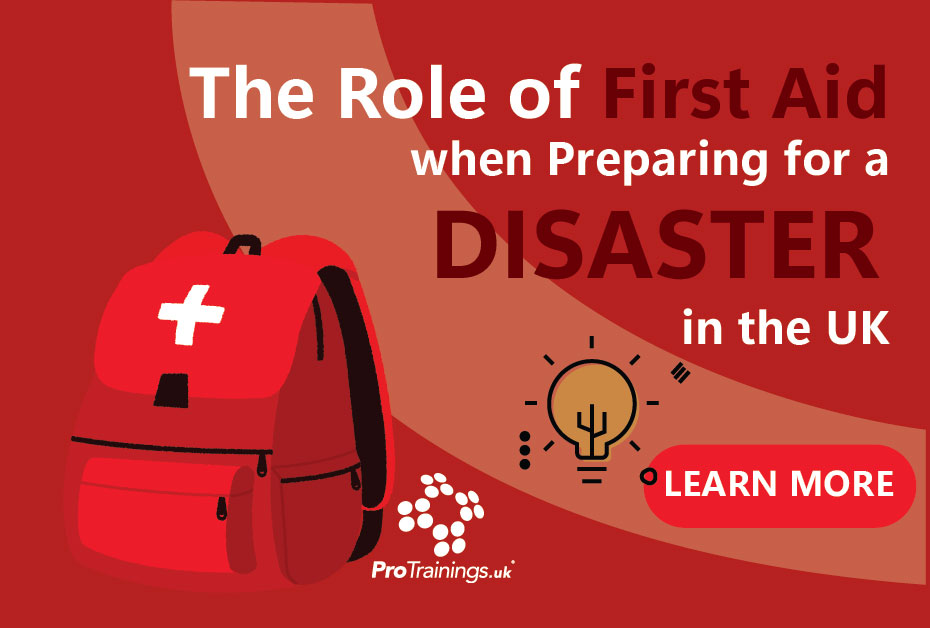The Role of First Aid when Preparing for a Disaster in the UK
Disasters can strike without warning, and being prepared is crucial to ensuring the safety and well-being of individuals and communities. First aid plays a vital role in disaster preparedness, equipping people with the skills and knowledge to respond effectively in emergencies. In the UK, where various natural and man-made disasters can occur, understanding the importance of first aid in disaster preparedness is essential for building resilient communities.
1. The Importance of First Aid in Disasters
First aid is often the first line of defence in any disaster scenario. Here’s why it’s so important:
- Immediate Response: In the critical moments following a disaster, first aid can prevent minor injuries from becoming life-threatening and provide essential care while waiting for emergency services.
- Life-Saving Skills: Knowing how to perform CPR, treat wounds, and manage shock can save lives, especially when medical professionals may be delayed due to the scale of the disaster.
- Empowerment: First aid training empowers individuals to take action in emergencies, reducing panic and increasing the likelihood of positive outcomes.
2. Types of Disasters in the UK
The UK faces a variety of potential disasters, each requiring specific preparedness strategies. Some of the most common include:
- Flooding: Heavy rainfall and coastal storms can lead to severe flooding, particularly in low-lying areas.
- Severe Weather: Snowstorms, heatwaves, and strong winds can cause widespread disruption and injuries.
- Terrorism: The threat of terrorist attacks requires a prepared population capable of responding to injuries caused by explosions or other violent events.
- Pandemics: Infectious diseases like COVID-19 have highlighted the importance of public health measures and first aid in managing widespread health crises.
- Fires: Both urban and rural fires can spread rapidly, causing burns and smoke inhalation injuries.
3. Key First Aid Skills for Disaster Preparedness
Being prepared for a disaster means having a solid understanding of key first aid skills that can be applied in various scenarios:
CPR and AED Use:
- Cardiopulmonary Resuscitation (CPR): CPR is a critical skill for restarting the heart and maintaining blood flow to vital organs during cardiac arrest.
- Automated External Defibrillator (AED): Knowing how to use an AED can greatly increase the chances of survival in cases of sudden cardiac arrest.
Bleeding Control:
- Applying Pressure: Immediate pressure to a wound can control bleeding until professional help arrives.
- Use of Tourniquets: In cases of severe limb injuries, applying a tourniquet can stop life-threatening bleeding.
Wound Care:
- Cleaning and Dressing: Properly cleaning and dressing wounds can prevent infections and promote healing, especially in disaster settings where medical resources may be limited.
Burn Treatment:
- Cooling Burns: Running cool water over a burn can reduce damage and pain. This needs to be done for at least 20 minutes to fully cool a burn.
- Covering Burns: Protecting the burn with a burn dressing and cling flim helps prevent infection.
Managing Shock:
- Recognising Symptoms: Symptoms of shock include pale, clammy skin, rapid breathing, and a weak pulse.
- Providing Comfort: Lying the person down and elevating their legs can help manage shock until emergency services arrive.
4. First Aid Kits for Disaster Preparedness
Having a well-stocked first aid kit is essential for disaster preparedness. Here’s what your kit should include:
Basic Supplies:
- Adhesive bandages in various sizes.
- Sterile gauze pads and adhesive tape.
- Wound dressings in medium and large
- Antiseptic wipes and ointment.
- Scissors, tweezers, and safety pins.
- Disposable gloves and face masks.
- Burn dressings
- Saline solution in pods and bottles
- Triangular bandage to make a sling
Emergency Tools:
- A manual for first aid and CPR.
- A flashlight with extra batteries.
- A whistle to signal for help.
- A thermal blanket for warmth.
- Tourniquet and haemostatic dressings like Woundclot. A citizenAID TourniKEY is a good low cost and effective tourniquet.
Medications:
- Personal medications with instructions.
- Pain relievers like paracetamol or ibuprofen.
- Antihistamines for allergic reactions.
- Medications for your pets
Special Items:
- A list of emergency contact numbers.
- Copies of personal identification and important documents.
- A small supply of food and water, if space allows.
5. Community Preparedness and First Aid Training
Preparedness goes beyond individual readiness; it involves entire communities:
- First Aid Training: Encouraging community members to undergo first aid training increases the number of people capable of providing assistance during a disaster.
- Community Drills: Regular drills help people practice their first aid skills and disaster response, ensuring they know what to do when the time comes.
- Building a Support Network: Communities that work together can better support vulnerable individuals, such as the elderly or those with disabilities, during a disaster.
6. The Role of Government and Organisations
The UK government and various organisations play a crucial role in promoting first aid and disaster preparedness:
- Public Awareness Campaigns: Initiatives like “Prepared for Emergencies” aim to educate the public about the importance of first aid and emergency planning.
- First Aid Courses: ProTrainings offer first aid courses tailored to disaster preparedness.
- Emergency Services Collaboration: Coordination between emergency services and community organisations ensures a unified and effective response to disasters.
Conclusion
First aid is an integral part of disaster preparedness in the UK. By equipping individuals and communities with the necessary skills and knowledge, we can enhance our resilience and ability to respond to emergencies. Whether through first aid training, maintaining a well-stocked kit, or participating in community preparedness efforts, everyone has a role to play in ensuring safety during disasters.
